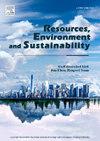Environmental responsibilities embodied in consumption behavior: A comparison between urban and rural residents in China
IF 12.4
Q1 ENVIRONMENTAL SCIENCES
引用次数: 0
Abstract
The environmental impacts of consumption behavior are not evenly distributed across different groups. Here, we develop an analytical framework by integrating input–output analysis, Lorenz curves drawing, spatial disequilibrium decomposition, and geographic transfer identification, enabling quantify the disparities in environmental responsibilities between urban and rural residents’ consumption behaviors. This framework is applied to China, the most populous country globally, for case study integrating three key dimensions: water consumption, fossil energy usage, and carbon emissions. The water resource, energy, and climate responsibilities associated with the urban residents’ consumption behavior were 2.68–2.92, 3.08–3.40, and 3.12–3.46 times that of rural residents in the three investigable years. Rural per capita consumption environmental footprints were less than half of urban residents. Provinces representing 20% of China’s urban and rural population generate 27%–36% of the country’s blue water, fossil energy, and carbon footprints. The spatial disequilibrium of residents’ consumption environmental responsibilities is significant but shows a weakening trend. Coastal developed regions tend to be net inflow areas of embodied water, fossil energy, and carbon dioxide, transferring embodied environmental pressures to inland regions. A progressive consumption footprint tax policy that considers contribution to economic growth is a potential approach for redistributing the consumption responsibilities between urban and rural residents.

消费行为中体现的环境责任:中国城乡居民的比较
消费行为对环境的影响在不同人群中分布并不均匀。本文通过投入产出分析、洛伦兹曲线绘制、空间非均衡分解和地理转移识别等方法,构建了一个分析框架,量化了城乡居民消费行为之间的环境责任差异。本文将这一框架应用于全球人口最多的国家中国,并结合三个关键维度进行案例研究:水消耗、化石能源使用和碳排放。3年城市居民消费行为的水资源、能源和气候责任分别是农村居民的2.68 ~ 2.92倍、3.08 ~ 3.40倍和3.12 ~ 3.46倍。农村人均消费环境足迹还不到城市居民的一半。占中国城乡人口20%的省份生产了全国27%-36%的蓝水、化石能源和碳足迹。居民消费环境责任的空间非均衡显著,但有减弱趋势。沿海发达地区往往是隐含水、化石能源和二氧化碳的净流入地区,将隐含的环境压力转移到内陆地区。考虑到对经济增长贡献的累进消费足迹税政策是在城乡居民之间重新分配消费责任的一种潜在方法。
本文章由计算机程序翻译,如有差异,请以英文原文为准。
求助全文
约1分钟内获得全文
求助全文
来源期刊

Resources Environment and Sustainability
Environmental Science-Environmental Science (miscellaneous)
CiteScore
15.10
自引率
0.00%
发文量
41
审稿时长
33 days
 求助内容:
求助内容: 应助结果提醒方式:
应助结果提醒方式:


